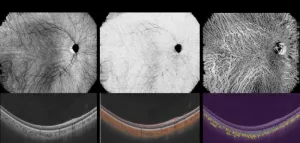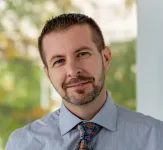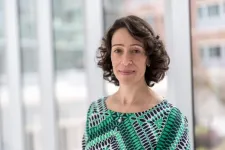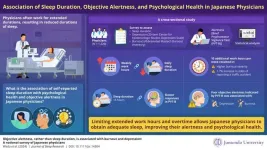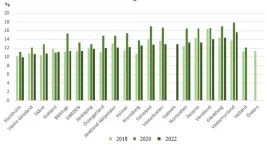(Press-News.org) Alongside artificial intelligence, quantum computing is one of the fastest-growing subsets in the high-performance computing community. But what happens when this relatively new and powerful computing method reaches the limit of the cyberinfrastructure and network security capabilities of today?
Researchers at the National Center for Supercomputing Applications are addressing this issue before it becomes a problem.
“The problem is urgent because practical quantum computers will break classical encryption in the next decade,” said NCSA Research Scientist Phuong Cao. “The issue of adopting quantum-resistant cryptographic network protocols or post-quantum cryptography (PQC) is critically important to democratizing quantum computing. The grand question of how existing cyberinfrastructure will support post-quantum cryptography remains unanswered.”
Cao and Jakub Sowa, a University of Illinois Urbana-Champaign undergraduate student and participant in the Illinois Cyber Security Scholars Program as well as the CyberCorps: Scholarship for Service, presented a paper on this topic at September’s IEEE International Conference on Quantum Computing and Engineering in Montreal. Their findings proposed the design of a novel PQC network instrument housed at NCSA and the University of Illinois, and integrated as a part of the FABRIC testbed; showcased the latest results on PQC adoption rate across a wide spectrum of network protocols; described the current state of PQC implementation in key scientific applications like OpenSSH and SciTokens; highlighted the challenges of being quantum-resistant; and emphasized discussion of potential novel attacks.
“The main challenges of adopting PQC lie in algorithmic complexity and hardware, software and network implementation,” Cao said. “This is the first large-scale measurement of PQC adoption at national-scale supercomputing centers and our results show that only OpenSSH and Google Chrome have successfully implemented PQC and achieved an initial adoption rate of 0.029% at this time.”
Cao is the principal investigator in a recent $200,000 award from the U.S. National Science Foundation (NSF) for a plan on “Quantum-Resistant Cryptography in Supercomputing Scientific Applications.” This will enable a network instrument to measure the adoption rate of PQC and allow universities and research centers to switch to PQC in order to safeguard sensitive data and scientific research. The project will set a national example of migrating cyberinfrastructure to be quantum resistant and build public trust in the security of scientific computing by demonstrating the increased adoption rate over time.
Cao is joined by co-principal investigators and NCSA researchers Anita Nikolich, Ravishankar Iyer and Santiago Núñez-Corrales.
“Transitioning to PQC algorithms across sectors will be a lengthy process,” Nikolich said. “Our work will be the first step to understanding the scope of the problem in the scientific infrastructure community. FABRIC touches multiple locations across the globe, which will give us good points of visibility into the challenge.”
“Quantum computing’s inherent uncertainty presents a unique opportunity to both obscure cryptographic computations and develop novel applications that exploit this uncertainty,” Iyer said. “This proposal aims to explore similar challenges, leveraging NCSA’s world-class computing resources to investigate new attacks targeting supercomputing workloads that were previously impractical.”
“This project opens a new avenue into NCSA’s quantum strategy. Potential future risks introduced by quantum technologies reconfigure now our understanding of the landscape of trust and security in advanced computing,” Núñez-Corrales said. “Mapping the adoption of PQC protocols will provide valuable information toward hardening NSF-funded cyberinfrastructure nationally. We anticipate this to be a significant and lasting contribution. In addition, and as collaborators within the Illinois Quantum Information Science and Technology Center (IQUIST), our project creates opportunities to interface the expertise of theorists in Quantum Information Science on campus with security concerns found in the regular operation of leadership-class supercomputing facilities.”
“This project will provide valuable input to plans for transitioning SciTokens to PQC, ensuring that our federated ecosystem for authorization on distributed scientific computing infrastructures is prepared to resist quantum computing attacks,” said NCSA Principal Research Scientist Jim Basney and principal investigator of the NSF-funded SciTokens project. “Understanding the efficiency of token signing and verification, along with the impact on token length, will be essential for planning a smooth transition.”
In August, the U.S. Department of Commerce’s National Institute of Standards and Technology (NIST) finalized its principal set of encryption algorithms designed to withstand cyberattacks from a quantum computer. The results of an eight-year effort by NIST, these encryption standards are an example of the necessary commitment to future computing security, which Cao is involved in through the NIST High Performance Security Working Group.
ABOUT NCSA
The National Center for Supercomputing Applications at the University of Illinois Urbana-Champaign provides supercomputing, expertise and advanced digital resources for the nation’s science enterprise. At NCSA, University of Illinois faculty, staff, students and collaborators from around the globe use innovative resources to address research challenges for the benefit of science and society. NCSA has been assisting many of the world’s industry giants for over 35 years by bringing industry, researchers and students together to solve grand challenges at rapid speed and scale.
END
Security in quantum computing
2024-11-04
ELSE PRESS RELEASES FROM THIS DATE:
Noninvasive choroidal vessel analysis via deep learning: A new approach to choroidal optical coherence tomography angiography
2024-11-04
Researchers from Peking University have developed a novel noninvasive choroidal angiography method that enables layer-wise visualization and evaluation of choroidal vessels using deep learning. This new approach, published in Health Data Science, employs an advanced segmentation model that can handle varying quality of optical coherence tomography (OCT) B-scans, making it a promising tool for clinical applications in diagnosing retinal diseases.
Choroidal Optical Coherence Tomography Angiography (C-OCTA) offers a significant improvement in the analysis of choroidal vessels, a critical component in the ...
National Multiple Sclerosis Society awards $1M to Case Western Reserve University researchers to study new approach to treat the disease
2024-11-04
CLEVELAND—Multiple sclerosis (MS) is a debilitating disease of the brain and spinal cord that impacts millions worldwide.
In MS, the immune system mistakenly attacks the myelin sheath—a protective layer surrounding nerve cells in the nervous system. The loss of myelin, combined with ongoing inflammation, causes dysfunction and death of nerve cells, making the disability worse, such as difficulties with movement, coordination, and sensation.
Treatments now focus on reducing attacks on myelin, but don’t address nerve-cell damage and death.
But with $1 million from the National Multiple ...
Virginia Tech researchers find menthol restrictions may drive smokers to healthier alternatives
2024-11-04
Nationwide, fewer people smoke than did a decade ago, but the proportion who smoke menthol-flavored cigarettes is on the rise.
More than 9 million adults, or about 32 percent of all smokers, use menthol cigarettes, according to the Centers for Disease Control and Prevention. In Virginia, the proportion stands higher, at 38 percent.
A team of researchers including Roberta Freitas-Lemos, assistant professor at Virginia Tech’s Fralin Biomedical Research Institute at VTC, found that if menthol products were unavailable, smokers found replacement therapies such as nicotine gum and lozenges were practical alternatives, potentially improving health outcomes for people who use menthol ...
Japanese study reveals the importance of new overtime restrictions on physician’s mental health
2024-11-04
Physicians are a vital component of the healthcare landscape and along with other medical professionals, they ensure timely diagnosis, treatment, and management of complex illnesses. They regularly work extended and overnight shifts, often at the cost of sleep. However, the long duty hours of physicians can lead to physical and mental exhaustion, resulting in negative consequences such as depression and burnout. Consequently, this can affect their level of alertness and thus the quality of patient care. To protect the health of Japanese physicians, a duty hour reform went into effect ...
Space: A new frontier for exploring stem cell therapy
2024-11-04
Stem cells grown in microgravity aboard the International Space Station (ISS) have unique qualities that could one day help accelerate new biotherapies and heal complex disease, two Mayo Clinic researchers say. The research analysis by Fay Abdul Ghani and Abba Zubair, M.D., Ph.D., published in NPJ Microgravity, finds microgravity can strengthen the regenerative potential of cells. Dr. Zubair is a laboratory medicine expert and medical director for the Center for Regenerative Biotherapeutics at Mayo Clinic in Florida. Abdul Ghani is a Mayo Clinic research technologist. Microgravity is weightlessness ...
History of concussion linked to higher risk of severe mental illness after childbirth
2024-11-04
Toronto, ON, November 4, 2024 – People with a history of concussion face a 25% higher risk of having severe mental health issues after childbirth, according to a new study from ICES and the University of Toronto.
The research underscores the importance of identifying individuals with past concussions early in their prenatal care and highlights the need for long-term, trauma-informed support to safeguard their mental health.
“We found that individuals with a history of concussion were significantly more likely to experience serious mental health challenges, ...
Combining two simple tools could combat election misinformation
2024-11-04
ITHACA, N.Y. – A popular new strategy for combatting misinformation doesn’t by itself help people distinguish truth from falsehood but improves when paired with reminders to focus on accuracy, finds new Cornell University-led research supported by Google.
Psychological inoculation, a form of “prebunking” intended to help people identify and refute false or misleading information, uses short videos in place of ads to highlight manipulative techniques common to misinformation, such as emotional language, false dichotomies and scapegoating. The strategy has already been deployed ...
Nanoscale transistors could enable more efficient electronics
2024-11-04
CAMBRIDGE, MA – Silicon transistors, which are used to amplify and switch signals, are a critical component in most electronic devices, from smartphones to automobiles. But silicon semiconductor technology is held back by a fundamental physical limit that prevents transistors from operating below a certain voltage.
This limit, known as “Boltzmann tyranny,” hinders the energy efficiency of computers and other electronics, especially with the rapid development of artificial intelligence technologies that demand faster computation.
In an effort to overcome this fundamental limit of silicon, MIT researchers fabricated a different type ...
UChicago scientist develops paradigm to predict behavior of atmospheric rivers
2024-11-04
When torrential rains and powerful winds hit densely populated coastal regions, whole cities can be destroyed—but governments and residents can take precautions with sufficient warning.
Many of these coastal deluges are caused by atmospheric rivers—regions of concentrated water vapor carried along on strong winds, sometimes called “rivers in the sky.” Meteorologists monitor them, but the ability to predict exactly how an atmospheric river might behave based on its underlying physics would offer more precise forecasts.
In a paper published today in Nature Communications, senior author Da Yang, assistant professor of geophysical sciences at the University ...
Childhood overweight is associated with socio-economic vulnerability
2024-11-04
More children have overweight in regions with high rates of single parenthood, low education levels, low income and high child poverty. The pandemic may also have reinforced this trend. This is shown by a study conducted by researchers at Uppsala University and Region Sörmland in collaboration with Region Skåne.
“During and after the pandemic, we see a greater difference between regions in terms of children's weight. It even looks like it has exacerbated health inequalities,” explains ...
